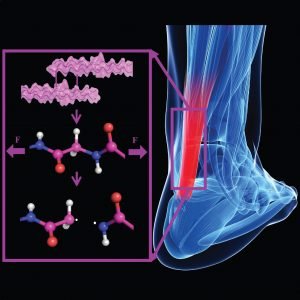Simulations of Collagen Failure and Mechanoradicals

It has been known for many decades that synthetic polymers subjected to mechanical stress generate mechanoradicals by rupture of chemical bonds. But could those harmful and highly reactive radicals also form in our tissues when stretched? Imagine your achilles tendon: It is made from collagen, which is the basic material of e.g. tendons, cartilage, ligaments and bones. These tendons are often under extreme loads, for example while doing sports or walking.
In this project, we employ computational techniques like Molecular Dynamics simulations of the collagen fibril, comprising millions of atoms. Chemical bonds break at sites of high stress concentration when collagen is stretched. We built a collagen fibril model in atomistic resolution to determine on the microscopic level what happens during pulling and developed a new simulation scheme called KIMMDY (Kinetic Monte Carlo / Molecular Dynamics) to directly see where the bond ruptures are occurring. Further, we follow how the subsequently created radical species migrate inside collagen by quantum mechanical simulations. Our combined computational approach alows us to explore how radicals could potentially act in signalling processes.
We continue examining this connection between mechanical and chemical stress and the role of collagen as a radical sponge also by complementing the computational studies by experiments like EPR (Electron-paramagnetic resonance) measurements on collagen fibers in our new MBM-laboratories at the University Heidelberg. Check it out here!
More information:
Mechanoradicals in tensed tendon collagen as a source of oxidative stress
Christopher Zapp, Agnieszka Obarska-Kosinska, Benedikt Rennekamp, Markus Kurth, David M. Hudson, Davide Mercadante, Uladzimir Barayeu, Tobias P. Dick, Vasyl Denysenkov, Thomas Prisner, Marina Bennati, Csaba Daday, Reinhard Kappl & Frauke Gräter
Nature Communications
Hybrid Kinetic Monte Carlo / Molecular Dynamics Simulations of Bond Scissions in Proteins
Benedikt Rennekamp, Fabian Kutzki, Agnieszka Obarska-Kosinska, Christopher Zapp, and Frauke Gräter
Journal of Chemical Theory and Computation